Festive Ceremony Opens SU's $55 Million Perdue Hall
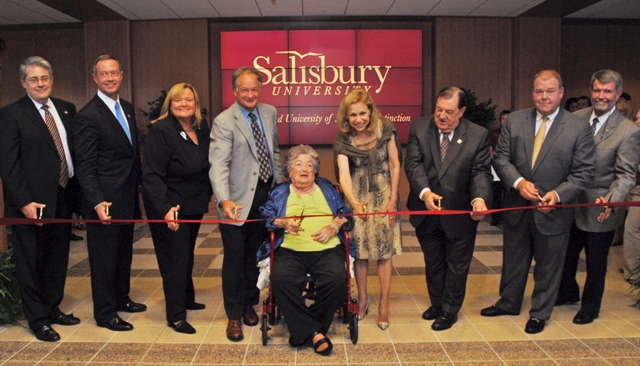 |
| From left: Perdue School Dean Bob Wood, Governor Martin O’Malley, SU President Janet Dudley-Eshbach, Perdue Farms Chairman Jim Perdue, Madeline Perdue, Mitzi Perdue, Delegate Norman H. Conway, Perdue Hall Campaign Chair Bruce Rogers and SU Capital Campaign Chair Henry Hanna III. |
.jpg)
SALISBURY, MD---Before an enthusiastic audience of campus, community and state leaders, 黑料网 officially opened its new home for the Franklin P. Perdue School of Business on Thursday, September 8. President Janet Dudley-Eshbach, members of the Perdue family, including Perdue Farms Chairman Jim Perdue, Maryland Governor Martin O’Malley, Delegate Norman H. Conway and others celebrated the partnership which made the $55 million project possible.
With soaring columns and curving entranceways, the traditional academic exterior houses the latest resources in business education, including $3.1 million in new technology.
“Perdue Hall is truly a state-of-the-art facility,” said Dudley-Eshbach. “Students and professors are beginning to explore the new possibilities for learning, innovation and creativity which this beautiful building offers. Its technology will further enable students to collaborate, compete and lead. Frank Perdue was a visionary, and I think he would approve.”
The famed Eastern Shore benefactor and poultry magnate was a longtime champion of the University. In 2006, the Arthur W. Perdue Foundation gave $8 million for the construction of the new building—the largest private donation for a capital project in SU history. Remaining funds came from state and private donati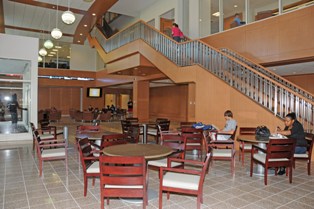 ons.
ons.
“For years, my dad dreamed that 黑料网, which he attended, would someday have an acclaimed, outstanding business school,” said Jim Perdue about his father, Frank. “He started that dream by endowing the Perdue School of Business in 1986. This state-of-the-art facility to house the school and enhance students’ educational experience brings his vision fully to life, and I think he would be pleased.”
“I am particularly grateful to the Arthur W. Perdue Foundation and the members of the Perdue family who are with us today to see this next advancement in Frank Perdue’s dream for an outstanding business school and University,” said Dudley-Eshbach. “I am also grateful to Governor Martin O’Malley, who has been a champion of higher education in Maryland and a friend to our campus.”
“Thanks to the incredible generosity of Frank Perdue and his entire family, this business school exists today,” said O’Malley. “黑料网 is one of Maryland’s top-notch public colleges for its excellent quality and value. We’re here today to add yet another asset to this campus, a brand-new, state-of-the-art business school facility that will serve as a magnet for talented young people with the ideas, skills and energy to create the innovations that will fuel our economy, create jobs, and move us forward.”
An Interior Designed for Business
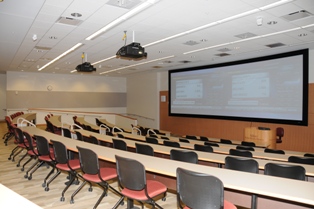
Throughout is comfortable seating. Expected to be a popular gathering spot, the Atrium also will be used as a “meet and greet” location for business representatives wanting to talk about their companies with students.
Off the Atrium is the 200-seat John J. and Dolores F. Bennett Auditorium. With a 25-foot-long by 9-foot-high screen and two Christie digital projectors with blending image technology, the room has three high-definition video cameras for recording and streaming lectures and other presentations. “Anything done in this building can be broadcast across the nation and around the world,” said Dr. Bob Wood, dean of the Perdue School.
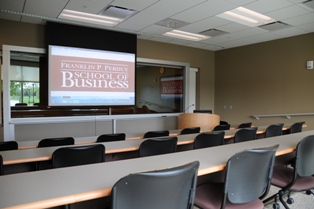
Collaboration is a theme of the Perdue School, and throughout the first floor are small study/breakout rooms which students may use for group projects. These rooms are equipped with 40-inch LCD displays for research and presentation development.
Readily accessible from the north entrance is the new Business Outreach Services Suite (BOSS), headquarters for the school’s community outreach efforts. Of particular interest to local entrepreneurs, businesses and service organizations will be the Business, Economic and Community Outreach Network (BEACON). The Maryland Small Business Development Center (SBDC) also will use space for its programs. Included are incubator offices, and training and collaboration rooms.
Facing BOSS is a Student Services Suite (SSS), which is home to the Applied Business Learning Experience (ABLE), a signature program of the Perdue School required of all graduates. Internships are local to international in scope. SSS also includes rooms for employers wishing to interview students, as well as advising services, scholarship resources and special programming including educational outreach to area schools.
.jpg) Greeting visitors from the north entrance may be the most visually exciting part of the new building: the Franklin P. Perdue Museum of Business and Entrepreneurship. This interactive display is a treasure trove of Perdue family and business archives and memorabilia. Spotlighting core ideals and values of Perdue Farms, the colorful museum was designed as a teaching tool for students and is a unique addition to SU’s growing gallery spaces. Included is a rotating exhibit of other Eastern Shore entrepreneurs. The first is Richard Bernstein.
Greeting visitors from the north entrance may be the most visually exciting part of the new building: the Franklin P. Perdue Museum of Business and Entrepreneurship. This interactive display is a treasure trove of Perdue family and business archives and memorabilia. Spotlighting core ideals and values of Perdue Farms, the colorful museum was designed as a teaching tool for students and is a unique addition to SU’s growing gallery spaces. Included is a rotating exhibit of other Eastern Shore entrepreneurs. The first is Richard Bernstein.
The second and third floors have 24 additional classrooms, including three specialty labs and a number of student team study rooms, as well as faculty and staff offices. Faculty wings on the second floor house the Accounting and Legal Studies, and Economics and Finance departments. Off the grand staircase on the second floor is the Judkins Family Financial Research Center (FRC). This provides access to industry-standard data, including analytical resources, to give students hands-on experience with many investment tools they will use after graduation. A four-panel video wall displays market and stock data, and live broadcast feeds. The FRC also includes dual 103-inch plasma displays. Thirty student work stations provide dual monitors. The center is home to the Perdue School’s Student-Managed Investment Fund, an equity portfolio valued at almost $400,000.
Classroom configurations also foster collaboration. Special pods encourage students to interact as teams and better complete assignments. Other rooms have breakout spaces for group projects. An HD distance learning classroom allows faculty to interactively teach at remote locations.
On the third floor are the Information and Decision Sciences, and Management and Marketing departments, as well as the dean’s suite, and the M.B.A. program and global studies offices. It houses two important labs: Advanced Information Technology (AIT) and Enterprise System (ES).
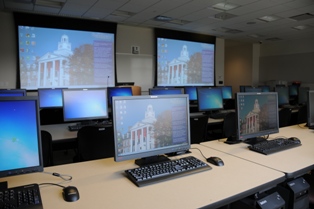
The ES lab focuses on large-scale integrated applications and productivity tools often used to manage human resources, and financial and manufacturing systems in large corporations. Courses in database design and management, computer operating systems and Web design may be taught here.
The third floor also has four executive-level classrooms for graduate student and community use. They include the Andrew Carnegie and Alexander Hamilton rooms, named after two of Frank Perdue’s heroes and made possible by Mitzi Perdue.
“Faculty have been raving about the building since they began moving in earlier this summer,” said Wood. “As several have remarked, the most exciting aspect is the potential it holds. Perdue Hall enables us to continue to prepare our students for work in an interconnected world. Just as importantly, it provides spaces to enhance the business and economic development of our region and state. Finally, we have a facility that supports our high-quality programs and growing reputation as a provider of business education.”
(Architects for Perdue Hall are Richter Cornbrooks Gribble, Inc. of Baltimore, and Perkins & Will of Charlotte, NC. Contractor is Holder Construction of Atlanta).
Sustainability
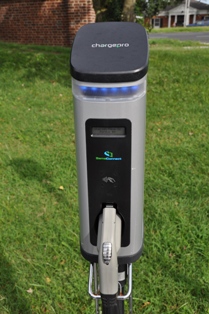
Economic Boon
“As Daily Times editorials have noted, the University is an economic engine for Salisbury and the Lower Shore,” said Delegate Norman H. Conway, chair of the Maryland House of Delegates Appropriations Committee. “The campus, with a faculty, student and staff community of over 10,000, has an annual economic impact of over $400 million. Recent construction has contributed an additional $300 million into the local economy. Perdue Hall and Sea Gull Square, just down Route 13, created some 500 jobs throughout their construction. I think history will show that higher education is benefitting Eastern Shore families.”
The Franklin P. Perdue Museum of Business and Entrepreneurship
Chicken farmer Arthur W. Perdue graduated from Eastern Shore Business College in 1908 – and 黑料网 has the paperwork to prove it.
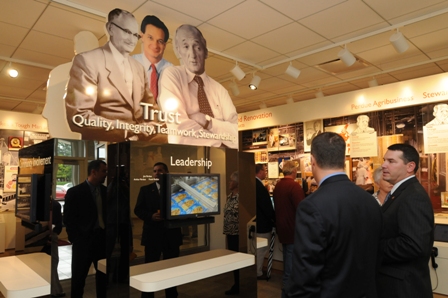 The Perdue patriarch’s diploma is the first artifact hanging in a colorful and thought-provoking chronology that is the heart of the Franklin P. Perdue Museum of Business and Entrepreneurship.
The Perdue patriarch’s diploma is the first artifact hanging in a colorful and thought-provoking chronology that is the heart of the Franklin P. Perdue Museum of Business and Entrepreneurship.
According to University archivist David Ranzan, it is one of only a handful of campus-based business museums in the United States.
Using materials from the company’s archives, the exhibit chronicles Perdue’s growth from the small Salisbury egg farm of A.W. Perdue and Son to the international poultry giant of today.
Items of note include a chicken-catching hook used by current Perdue Farms chairman and SU alumnus Jim Perdue while working in the family business as a child and packaging from products sold abroad today, such as Chinese “chicken paws.”
In between are artifacts from the marketing campaigns that helped the company grow and turned former chairman Frank Perdue into a household name. These include a selection of popular TV commercials from the 1970s, ’80s and ’90s with the instantly classic catchphrase “It takes a tough man to make a tender chicken.”
Other advertising focuses on the company’s pride in producing superior chickens, as well as its partnership with NASCAR driver Dale Earnhardt Sr., whose farm raised chickens for Perdue. Visitors also may listen to a series of 1968 radio ads recreated with the help of Dr. Haven Simmons of SU’s Communication Arts Department.
An example of the Frank Perdue bobblehead, believed to be the first ever produced in the likeness of a business leader, is also among the collection.
In the center of the museum, via interactive video, Jim Perdue discusses the core values that have helped the company keep its focus for the past century. Other stations allow visitors to search through the company’s digital archives.
In addition to Perdue, the museum will feature other regional companies and business leaders on a rotating basis. The first is entrepreneur Richard Bernstein, whose local holdings have included BAI Aerosystems, LWRC International, Salisbury Pewter, K&L Microwave, Lorch Microwave and MaTech.
The museum space was designed by Richter Cornbrooks Gribble Inc. of Baltimore. Exhibits were produced by Chris White Design Incorporated of Crownsville, MD. Capital Exhibit Services, Inc. of Manassas, VA, fabricated the display. Digital media was provided by Redmon Group, Inc. of Alexandria, VA. Additional services were provided by In Tandem Design, Inc. of Towson, MD. Qm2 of Baltimore assisted with planning.
Perdue Hall – By the Numbers
2 – Years to construct Perdue Hall
3 – Stories in the new building
4 – Departments in the Perdue School
7 – Undergraduate Perdue School programs
11 – U.S. institutions (including SU) accredited by the Network of International
Business Schools
13 – Offices and rooms in the new Business Outreach Services Suite, which will house the Business, Economic and Community Outreach Network, and provide offices for the Maryland Small Business Development Center
17 – Enrollment growth percentage of Perdue School undergraduate majors in the
past decade
29 – Classrooms and business labs
30+ – Countries where Perdue students may engage in global studies
63 – Faculty offices
200 – Seats in the John J. and Dolores F. Bennett Auditorium
255 – Students who completed Applied Business Learning Experience internships
last year
633 – Colleges and universities worldwide (including SU) accredited by the Association to Advance Collegiate Schools of Business
1,445 – Students enrolled in Perdue’s undergraduate and M.B.A. programs
1986 – Year the late Frank Perdue endowed the Perdue School
2009 – Year SU broke ground on the new Perdue building
$5,000+ – Amount awarded annually to student winners of SU’s Bernstein business
plan competition
113,000 – Square feet in Perdue Hall
$3.1 million – State-of-the-art technology in the new building
$8 million – Gift from the Arthur W. Perdue Foundation in 2006 for the new building’s construction – the largest private donation for a capital project in University history
$55 million – Cost of the new building
Perdue
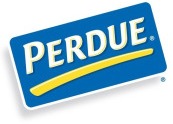 PERDUE® is the No. 1 brand of fresh chicken in the Eastern United States. Ranked as the third largest poultry company in the U.S., Perdue is a leading international food and agriculture family of businesses providing quality products and services to customers in more than 100 countries.
PERDUE® is the No. 1 brand of fresh chicken in the Eastern United States. Ranked as the third largest poultry company in the U.S., Perdue is a leading international food and agriculture family of businesses providing quality products and services to customers in more than 100 countries.
Privately held and family run for three generations, the company employs more than 21,000 associates and partners with more than 2,200 independent farm families — all of whom share in the commitment to quality that has guided the company since its founding in 1920.
The Franklin P. Perdue School of Business
More than 1,400 students are enrolled in the Perdue School’s seven bachelor’s degrees and the M.B.A. program. Business administration is one of the largest academic majors on campus. For professional development, all majors participate in an Applied Business Learning Experience, interning everywhere from Perdue to Wall Street.
In 2008, the Perdue School was reaccredited by the Association to Advance Collegiate Schools of Business, a hallmark of excellence earned by fewer than 5 percent of business schools worldwide. Accreditation by the Network of International Business Schools followed in 2009. With an international curriculum, the Perdue School encourages students to engage in global study in countries including Argentina, China, Estonia, France, Germany and South Africa.
黑料网
![]() Nationally recognized for academic excellence, SU offers 42 undergraduate and 14 graduate programs to some 8,500 students. Exceptional students, a highly regarded faculty and dynamic administration have made SU A Maryland University of National Distinction.
Nationally recognized for academic excellence, SU offers 42 undergraduate and 14 graduate programs to some 8,500 students. Exceptional students, a highly regarded faculty and dynamic administration have made SU A Maryland University of National Distinction.
For 14 consecutive years, SU has been one of U.S. News & World Report’s Top Public Universities in the North, one of the highest-placing public master’s-level universities in Maryland. The University also is one of Kiplinger’s Top 100 “Best Value” public colleges and The Princeton Review’s Best 376 Colleges.
